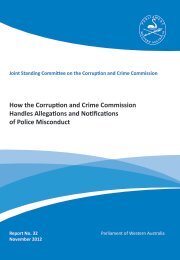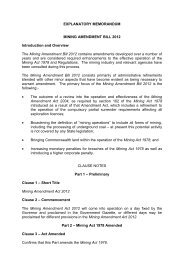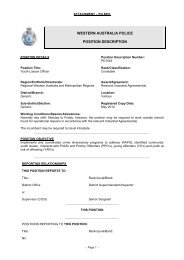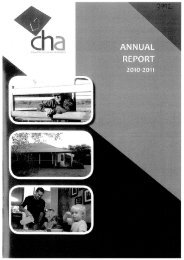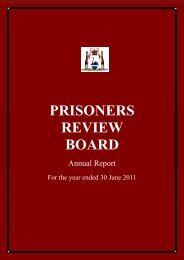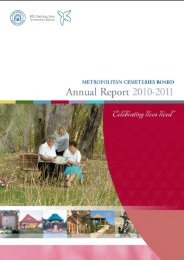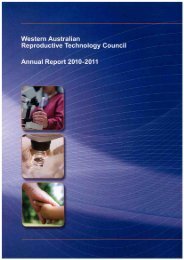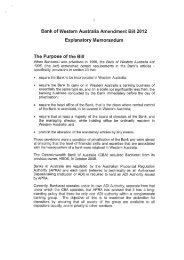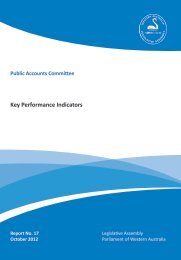Challenger TAFE | Annual Report 2006 - Parliament of Western ...
Challenger TAFE | Annual Report 2006 - Parliament of Western ...
Challenger TAFE | Annual Report 2006 - Parliament of Western ...
Create successful ePaper yourself
Turn your PDF publications into a flip-book with our unique Google optimized e-Paper software.
Key Performance Indicators<br />
<strong>Challenger</strong> <strong>TAFE</strong> | <strong>Annual</strong> <strong>Report</strong> <strong>2006</strong> 33<br />
CHALLENGER <strong>TAFE</strong>’S VISION AND MISSION<br />
The College’s aims to be a high performance, visionary organisation. As a member <strong>of</strong> <strong>TAFE</strong>WA, our mission is to provide<br />
training and related services that are enterprise and community driven, and career courses aligned with WA current and future<br />
skills requirements.<br />
CHALLENGER <strong>TAFE</strong>’S KEY DIRECTIONS FOR <strong>2006</strong>:<br />
To improve skill development and employment outcomes by:<br />
Goal 1 – Providing industry-driven training and related services to skill the workforce<br />
Goal 2 – Being the training provider <strong>of</strong> choice for industry, labour market entrants and community members<br />
Goal 3 - Building and maintaining a viable training organisation in a competitive global training market<br />
Goal 4 – Being an employer <strong>of</strong> choice<br />
Goal 5 – Continuously improving our business processes<br />
DESIRED OUTCOMES FOR <strong>2006</strong><br />
A key desired outcome for <strong>2006</strong> was timely, effi cient and effective vocational education and training and employment services<br />
successfully addressing employment, enterprise and community needs.<br />
The following effectiveness and effi ciency indicators have been developed to assist in the College’s monitoring and management<br />
processes and to enhance its accountability to its stakeholders. They are subject to audit under the provisions <strong>of</strong> the Financial<br />
Administration and Audit Act 1985.<br />
KEY INDICATORS OF PERFORMANCE EFFICIENCY<br />
The effi ciency and effectiveness <strong>of</strong> <strong>Challenger</strong> <strong>TAFE</strong>’s efforts to meet its community and industry training needs have been<br />
measured using four Key Performance Indicators. The measure <strong>of</strong> effi ciency that the College has applied is: Total delivery cost<br />
per SCH<br />
PERFORMANCE INDICATORS FOR EFFICIENCY BASED ON TOTAL DELIVERY COST PER SCH<br />
Every student at <strong>Challenger</strong> <strong>TAFE</strong> enrols in one or more modules. Each module is linked to a relevant course and has a nominal<br />
number <strong>of</strong> curriculum hours. Students’ enrolments in these modules generate Student Curriculum Hours (SCH). For each year,<br />
a cost per SCH target has been established based on the previous year’s results. The total operating costs include Capital User<br />
Charge and the costs have not been indexed against annual Cost <strong>of</strong> Living measures.<br />
The level <strong>of</strong> expenditure required to produce an output or product unit is a standard measure <strong>of</strong> effi ciency. The major unit <strong>of</strong><br />
product output for the <strong>Challenger</strong> <strong>TAFE</strong> is the Student Curriculum Hour and the cost per SCH provides an indicator <strong>of</strong> effi ciency.<br />
This year, there was an increase in delivery <strong>of</strong> employment-based training with the College exceeding its agreed targets. Delivery<br />
costs for this category are signifi cantly higher per SCH than for other State contracted delivery. A second factor impacting on<br />
the cost per SCH in <strong>2006</strong> was the salary increases for both lecturers and non-lecturing staff and the costs associated with the<br />
development <strong>of</strong> additional delivery site facilities. This has led to an increase in the Capital User Charges (which are included in<br />
the Cost per SCH calculation).<br />
COST PER SCH OF CHALLENGER <strong>TAFE</strong> TRAINING DELIVERY<br />
The output <strong>of</strong> <strong>Challenger</strong> <strong>TAFE</strong>’s training services and products are quantifi ed through the standard measure <strong>of</strong> Student<br />
Curriculum Hours (SCH). A measure <strong>of</strong> the College’s effi ciency is the cost per SCH.<br />
Source The Financial Data applied in the measure is from the <strong>2006</strong> Financial Statements included in this report. The total <strong>of</strong><br />
the Student Curriculum Hours <strong>of</strong> training delivered is as reported in Table 8.4 from the <strong>2006</strong> census provided to the <strong>Western</strong><br />
Australian Department <strong>of</strong> Education and Training in February 2007.<br />
Methodology: The average cost per Student Curriculum Hour is derived from the amount identifi ed as Cost <strong>of</strong> Services divided by<br />
the total Student Curriculum Hours delivered. The Cost per SCH inclusive <strong>of</strong> the Capital User Charge <strong>of</strong> $4,785,212 is shown in



